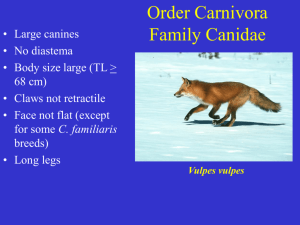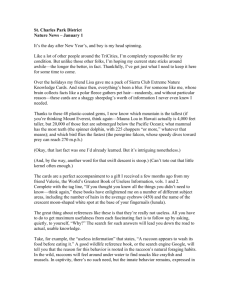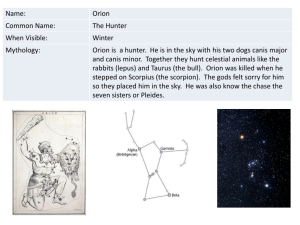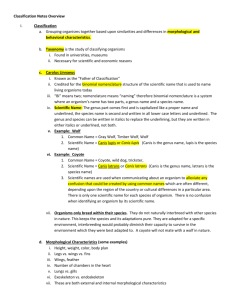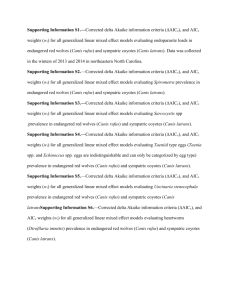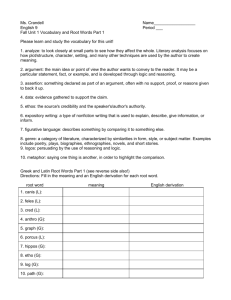Canis latrans - Natural Resource Ecology and Management
advertisement
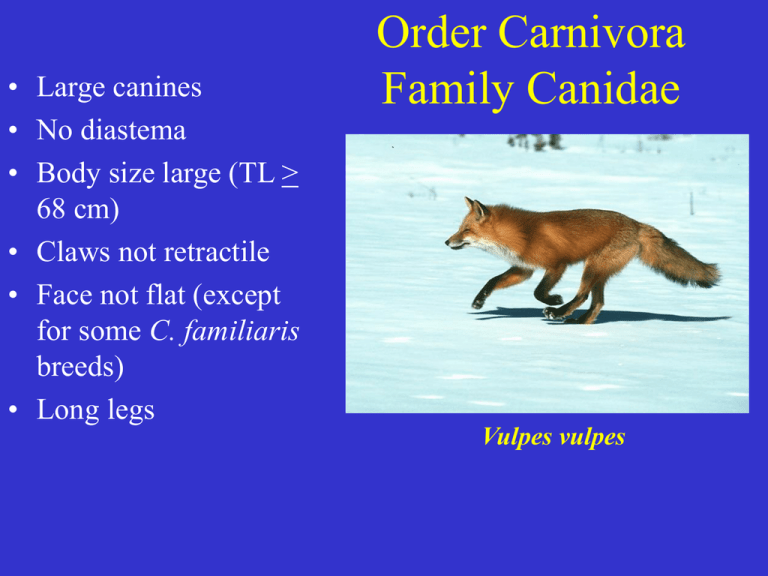
• Large canines • No diastema • Body size large (TL > 68 cm) • Claws not retractile • Face not flat (except for some C. familiaris breeds) • Long legs Order Carnivora Family Canidae Vulpes vulpes Canis latrans Coyote Sara Eubanks Canis latrans • Identification Smallest of New World wild canis, larger than any fox Dorsal color variable but grayishbrown to grayish buff Venter paler TL: 1050-1350, tail:290-390; HF:180-210; ear:95-120; weight: 9-20 kg Males larger, heavier than females www.lioncrusher.com/images/coyote.jpg Canis latrans • Distribution Widely throughout U.S. All of southern, south-central Canada South through Mexico into northern central America www.lioncrusher.com Canis latrans • Habitat Very adaptable Utilize wide range of habitats: forests, woodlots, clear cuts, farms Prefer habitats not containing wolves http://www.acapixus.dk/galleri/ images_html/KOL9974_dk.htm Canis latrans • Diet Opportunistic predator Mammalian flesh 90% of diet Eats rodents, rabbits, deer, carrion, livestock, lizards, amphibians, berries, fruit http://www.stockpix.com/stock/animals/mammals/predatorymammals/coyotes/2461s2.jpg Canis latrans • Reproduction Mating lasts 3 months January-March Females may mate with more than one male Female chooses mate, may remain with for couple of years but not life Gestation 60-63 days http://www.canis.info/caniden/derkojote.htm Canis latrans • Reproduction cont. Litter size: 1-19; average 6 Mom and dad feed pups by regurgitating food Young born blind, limp-eared, pug nosed Eyes open 10 days Females remain with parents, males leave Reach sexual maturity at 1 year Canis latrans • Conservation Status No special status at this time http://www.azuswebworks.com/ html/2coyotes.htm Canis latrans • Other Reservoir host of rabies Pelts used for coats Pelts sell for up to $17 More likely a daytime predator, more nocturnal Canis latrans • Other Higher-pitched howls than wolves with more yelps http://www.stockpix.com/stock/animals/mammals/predatorymammals/ coyotes/803.htm Canis latrans • References Coyote (Canis latrans). Accessed October 13, 2004 at http://www.canids.org/SPPACCTS/coyote.htm. Kays, R.W. and D.E. Wilson. 2002. The Mammals of North America. Princeton University press, Princeton, New Jersey. Jones, J.K. and E.C. Birney. 1988. Handbook of Mammals of the North-central States. University of Minnesota Press, Minneapolis. Tokar, E. 2001. "Canis latrans" (On-line), Animal Diversity Web. Accessed October 13, 2004 at http://animaldiversity.ummz.umich.edu/site/accounts/information/ Canis_latrans.html. The Dog Canis familiaris Katie Yahr Canis familiaris Identification • What makes a dog a dog? -Basic morphology similar to Canis lupis • Anal glands • Many different breeds www.thewildones.org Canis familiaris Distribution/ Habitat • Worldwide in a variety of habitats (especially under your feet or on the couch) •Most commonly found in association with humans Canis familiaris Diet • Dog food • Whatever they can reach on the counter • Feral dogs- negative impact on ecosystems Canis familiaris Reproduction • Sexually mature at 6-12 months • Gestation 9 weeks • Average of 3-9 puppies in a litter •Altricial young • In six years, one female dog and her offspring can theoretically produce 67,000 dogs! Canis familiaris Conservation Status • Overpopulated! • Management of feral populations • Be a responsible dog owner! news.nationalgeographic.com Canis familiaris References • http://fwie.fw.vt.edu/rhgiles/speciesssm/wdogs.ht m • http://news.nationalgeographic.com/news/2003/08 /0821_030821_straydogs.html • http://animaldiversity.ummz.umich.edu/site/accou nts/information/Canis_lupus_familiaris.html • http://www.petplace.com/articles/artShow.asp?artI D=1144 • www.hsus.org • www.aspca.org Red Fox (Vulpes Vulpes) By: Brad Froeschle www.floodlightfindings.com Identification • • • • • This small, doglike animal is rustyred with white underbelly, chin and throat. The ears are prominent and the tail is long and bushy with a white tip. Backs of the ears, lower legs and the feet are black. The fox goes through color phases of black, silver, and mixed. Dental Formula: 3/3, 1/1, 4/4, 2/3 The eyes of adults are yellow. Red foxes have tail glands. Between 5 and 15lbs and the length is between 32 and 45 inches. www.flloodfindings.com Red Fox Diet/Distribution • • • • • • The red fox is an omnivore. It generally eats mice, rats, other rodents, rabbits, squirrels, insects, and fruit. Mostly the red fox likes to eat mice. It is also famous for getting into farmers chicken houses and preying on farm chickens. The daily consumption consists between .5 and 1Kg a day. Red Foxes are found throughout Iowa. Habitats include forests, prairies, farmlands. www.floodfindings.com Reproduction • • • • • • The breeding season is between December and March. Sexual Maturity is reached around 10 months of age. Gestation is on average 52 days. Foxes have between 1 and 13 Kits. (avg. 5) Born blind but open eyes after 9 to 14 days. They are weaned between 8 and 10 weeks. Conservation Status/Etc. • • • • • • • • • • The red fox is not considered an endangered species in Iowa. Foxes use a variety of vocal calls to communicate between each other. Kingdom: Animalia Phylum: Chordata Subphylum: Vertebrata Class: Mammalia Order: Carnivora Family: Canidae Genus: Vulpes Species: Vulpes vulpes www.floodfindings.com References • Iowa Department of Natural Resources. Iowa’s threatened and endangered species. Available at http://www.state.ia.us/dnr/organiza/ppd/tespecies.htm. October 2004. • Nowak, R. M. 1991. Walker's Mammals of the World. The Johns Hopkins University Press, Baltimore, MD. Iowa Association of Naturalists. Iowa Mammals. http://www.extension.iastate.edu/Publications/IAN601.pdf. October 2004. • Urocyon cinereoargenteus Common name: Gray Fox http://members.tripod.com/~wildlifehave n/greyfox1.jpg Presented by Catherine Luria Urocyon cinereoargenteus • Order Carnivora http://www.canadianbiodiversity.mcgill.c a/data/sppphotos/mammals/greyfox.jpg – Family Canidae • Genus Urocyon –Species Urocyon cinereoargenteus Urocyon cinereoargenteus Identification • • • • • TL: 80-113 cm http://www.canadianbiodiversity.mcgill.c Tail: 27-43 cm a/data/sppphotos/mammals/greyfox.jpg Ear: 7-8 cm Hind foot: 12.5-14.5 cm Weight: 3-7 kg Urocyon cinereoargenteus Identification • Dorsum grizzled and gray http://www.canadianbiodiversity.mcgill.c • Sides and limbs a/data/sppphotos/mammals/greyfox.jpg cinnamon to orange • Underside tan to whitish • Black, white, and rufous markings on the face and neck • Dark stripe runs down back onto black-tipped tail Urocyon cinereoargenteus Distribution • Ranges from SE Canada to northern http://www.canadianbiodiversity.mcgill.c S. America a/data/sppphotos/mammals/greyfox.jpg • Found throughout central and eastern US, as well as along Pacific coast and in the southwest Urocyon cinereoargenteus Habitat • Wooded or brushy riparian habitats • Favors edge habitats • Home range is estimated to be 254-336 acres • Density in good habitat is 2-3 per sq. mile • Quite territorial http://www.foxes.org/urban fox/grey1.jpg Urocyon cinereoargenteus Habitat • Dens in hollow logs and trees, crevices in rocks, caves, piles of brush or wood, abandoned buildings, underground burrows • Used year round, but especially during whelping season http://www.foxes.org/urban fox/grey1.jpg Urocyon cinereoargenteus Habitat • Underground den may be up to 75 feet long • Up to 10 exits • Numerous side chambers for food storage and whelping • Mother moves pups to new chamber as old chamber becomes soiled http://www.foxes.org/urban fox/grey1.jpg Urocyon cinereoargenteus Diet • Most omnivorous of foxes • Feed on small mammals and birds, carrion, invertebrates, fruit, and corn http://www.foxes.org/urban fox/grey1.jpg Urocyon cinereoargenteus Reproduction • Mate in December through April Catherine Luria, 2004 • Gestation is 62 days • Bear litters of 1-7 “kits” (average of 4) • Kits are born with eyes closed, covered in black fur • Are able to eat solid foods by 6 weeks and forage by 4 months Urocyon cinereoargenteus Conservation Status • No special conservation status • Classed as a furbearer • Regulated hunting and trapping season http://www.floodlightfindings.com/2redfox/grayfox.html Urocyon cinereoargenteus Other • Only member of dog family to climb trees • Rabies vector http://www.floodlightfindings.com/2redfox/grayfox.html References Desert USA. The Gray Fox. Available at http://www.desertusa.com/nov96/du_gfox.html. October 2004. Jones, J. Knox, Jr. and Elmer C. Birney. 1988. Handbook of Mammals of the North-Central States. University of Minnesota Press, Minneapolis. Kays, Roland W. and Don E. Wilson. 2002. Mammals of North America. Princeton University Press, Princeton, NJ. Minnesota Department of Natural Resources. Gray Fox (Urocyon cinereoargenteus). Available at http://www.dnr.state.mn.us/snapshots/mammals/grayfox.html. October 2004. The Cyber Zoomobile. Gray Fox (Urocyon cinereoargenteus). Available at http://home.globalcrossing.net/~brendel/fox.html. October 2004. • • • • Large canines No diastema Claws not retractile Bushy, ringed tail Order Carnivora Family Procyonidae Procyon lotor Procyon lotor Raccoon BY: TAMI WETTERLIND Description Procyon lotor • • • • • • The mask extends across the cheeks, eyes and nose. There is also pale grey bars above and below the large eyes to complete the "mask" affect. The raccoon has a long fine coat and a busy tail with 4 to 7 prominent dark rings. The general color is a grizzled gray to a blackish color, with the sides greyer than the back. The nape of the neck can be a rusty color and the under-parts brownish with a whitish wash. The ears are edged with white or grayish hairs. Identification Procyon lotor • • • Males: 63-95 cm 20-40 cm • • • • Females: 60-91 cm 19-34 cm 4-15.8 kg • Forepaws are dexterous. The hind foot makes a print in which the toes and heel pad are joined whereas the front tracks toe and heel pad have a brief space between. • www.fishbc.com/adventure/wilderness/animals/raccoon.htm (larger picture.) www2.biology.ualberta.ca/uamz.hp/coon.html (smaller picture) Distribution Procyon lotor • This animal is native to the southern part of the Canadian provinces and most of the United States. • It is most common along stream edges, open forests and coastal marshes. • It is abundant throughout all of Iowa. • (picture from clipart) Habitat Procyon lotor • Inhabits hollow trees and logs for homes and often use the ground burrows of other animals for raising their young or for sleeping during the coldest part of the winter months • Also den near water, rock cavities, or any other crevice that will provide some protection • (picture from The Raccoon Gallery) Diet Procyon lotor • Omnivore, will eat almost anything edible including fruits, insects, frogs, fish, small mammals and birds, including their eggs, crayfish, turtles, berries, corn, meadow voles, and mice. • The raccoon uses its forepaws and its great manual dexterity to manipulate even the most complex food sources, including garbage cans, into its diet. • Picture from The Raccoon Gallery) Reproduction Procyon lotor • one litter a year • from 1 to 7 but usually 3 or 4 offspring. • The young are born in the summer (April-May) • stay with the mother during the winter until the next summer. • The male raccoon provides no parental care and will be aggressively chased from the den area by the female. • (Picture from The Raccoon Gallery) Conservation Status and Importance Procyon lotor • Abundant throughout all of Iowa. • Economically important for fur trade. • Predators: great horned owl and mammals such as bobcats, foxes, coyotes, or fishers. • (Picture from Managing Iowa Wildlife) Disease Procyon lotor • Rabies can be transmitted to humans or their pets from raccoons. • Incidence of rabies in animals is low in the Midwest. • Raccoon roundworm (Baylisascris) has potential exposure to trappers and hunters who might accidentally touch feces. Fun Facts Procyon lotor • Mainly nocturnal • Meaning of name: Procyon (pro = before + cyon = dog) lotor (washer)=little washing dog. • There are 26 separate subspecies of the raccoon, but only one is found in the Midwestern states. • (Picture from The Raccoon Gallery) References Procyon lotor • Kays, R.W. and D.E. Wilson. 2002. The Mammals of North America. Princeton University Press, Princeton, New Jersey. Pp 172. • Managing Iowa Wildlife. Available at: www.extension.iastate.edu/Publications/PM1302E.pdf, 1995. • Raccoon Procyon lotor. Available at: www.fishbc.com/adventure/wilderness/animals/raccoon.htm, 2004. • Raccoon. Procyon lotor. Available at: www.nature.ca/notebooks/english/racoon.htm, 2004. • The Raccoon at the University of Alberta Museum of Zoology. Available at: www2.biology.ualberta.ca/uamz.hp/coon.html, 2001. • The Raccoon Gallery. Available at: www.loomcom.com/raccoons/gallery/, 2004
